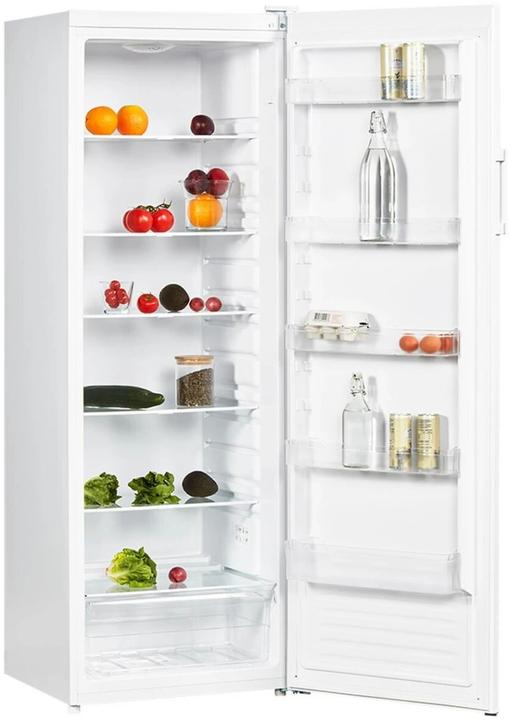

How to organise your fridge properly
The apples always get popped in the fridge door, the tomatoes go somewhere in the middle and the drinks get stored as far down as possible. At least, that’s the unspoken rule in my kitchen. I’ve never really cared enough to find out if that’s the right way to do it. Until now, that is...
Anything that was kept in chilled cabinets at the shop, I put in the fridge. My method is «it’ll go wherever there’s space». Sadly, I’m too lazy to make sure all the vegetables are stored together. That’s why you’ll find the salami under the cheese, with a few yoghurts in front of that and two bars of chocolate stashed beside them. The main thing is they’re still chilled, right?!
What’s important is the fact I rarely have stuff go off or past the expiry date. It helps that I eat leftovers at the weekend or take them for lunch at the office. I should also point out that there are a lot of things that don’t need to be kept in the fridge; I just prefer them cool – take chocolate, for example.
You could say my fridge is organised chaos. But since my girlfriend likes to remind me at every opportunity that I’m doing it all wrong, I decided to read up on where everything is supposed to be stored in the fridge.

The basics
If you don’t store food correctly, it’ll lose its nutritional value and, in the worst case scenario, it could go off before the expiry date. Here are the key guidelines to follow when it comes to looking after food in the fridge. Store them:
- as cool as possible (between 0℃ and 12℃)
- away from frost
- somewhere they won’t get too dry or wet
- in a dark place.
As much as possible, you want to keep food in packaging. This stops it drying out, going off too soon or transferring germs and odours.
Standard fridges can vary between 2℃ and 10℃. The bottom of the fridge is 2℃, while the middle is about 5℃ and the top shelves are a balmy 8℃. At roughly 10℃, the vegetable or crisper drawer (hint: for meat eaters, that’s usually the one at the bottom) and the door are the warmest parts of the fridge. It also tends to be cooler at the back wall and on glass plates. While the vegetable drawer is right at the bottom, it isn’t actually the coldest place in the fridge. That’s because the glass plate above it absorbs the cold, leaving the drawer somewhere between 5℃ and 8℃.

Vegetables
As the name suggests, the vegetable drawer is where your veg belongs. Just make sure you store things like carrots and radishes without all the green bits (stalks and leaves and whatnot). This stops them going off so quickly. Another important point to remember is that veg with a high water content shouldn’t be stored in the fridge at all.
This includes cucumber, peppers, tomatoes, courgettes, aubergines, pumpkin, green beans and potatoes. This type of vegetable has ripening genes that don’t develop the way you want them to when they’re refrigerated. Translated into practical terms, they lose their flavour and become bland. Conversely, vegetables that have already been cut can be stored in the fridge for a few days, as they’d go off too quick otherwise.
Fruit
Fruit also belongs in the crisper drawer, which would actually be more aptly called a fruit and veg drawer. But as with vegetables, there are also exceptions when it comes to which fruit to refrigerate. You don’t want to store the following in the fridge: mango, papaya, pineapple, bananas, strawberries, apricots, avocado, kiwi, melon, peaches, plums, oranges, lemons and other citrus fruit.
Meat, fish and sausages
These perishable goods belong in the bottom-most, coldest compartment just above the crisper drawer. You also need to make sure these products are always kept in sealed packaging to avoid the spread of smells and bacteria.
Dairy products and eggs
Milk and butter either go in the door or in the middle of the fridge. Meanwhile, cheese can be stored at the top of the fridge. What’s important is that you always keep it in sealed packaging so it doesn’t release any unwanted smells into your fridge.
As for eggs, they go in the compartment designed specially for them in the door. Mayonnaise, mustard, tomato puree, ketchup and ready-made sauces can also be safely stored in the door.
Drinks and prepared meals
Drinks belong in the bottom of the door. Alternatively, you can put them in the lowest compartment above the veg drawer. That way they’ll stay nice and cool. On the other hand, prepared meals that you want to keep fresh can get stored on the higher shelves, as the food has already been pre-cooked or fully cooked. Jam and pickled products can also go on the topmost shelf.
The right fridge
What’s important isn’t just how you store stuff in your fridge but also the type of fridge itself. For instance, it’s always better to buy a fridge that’s too big rather than too small for what you need. This lets the air circulate better and achieves the desired temperature everywhere.
Another issue with a fridge that’s too small is the amount of energy it uses. That’s because your fridge will waste energy trying to cool the areas that can’t be reached with air circulation.
For two-person households, I’d recommend a capacity of 120 to 140 litres. And for every extra person, you’ll want to add another 60 litres. Incidentally, modern devices boast almost the same temperature throughout.
What are known as multi-zone devices feature various cooling areas, such as a cold storage area with 0℃ and 50% humidity or a humidity drawer that’s also 0℃ but 90% humidity. However, the drawback to these devices is they’re very expensive and eating up a lot of electricity.
Chillin' with the fridge
What kind of fridge person are you?
- It is clean and tidy, of course.56%
- The main thing is that it is cooled36%
- For what, I put everything in the cellar.9%
The competition has ended.
When I'm not stuffing my face with sweets, you'll catch me running around in the gym hall. I’m a passionate floorball player and coach. On rainy days, I tinker with my homebuilt PCs, robots or other gadgets. Music is always my trusted companion. I also enjoy tackling hilly terrain on my road bike and criss-crossing the country on my cross-country skis.
Practical solutions for everyday problems with technology, household hacks and much more.
Show all



